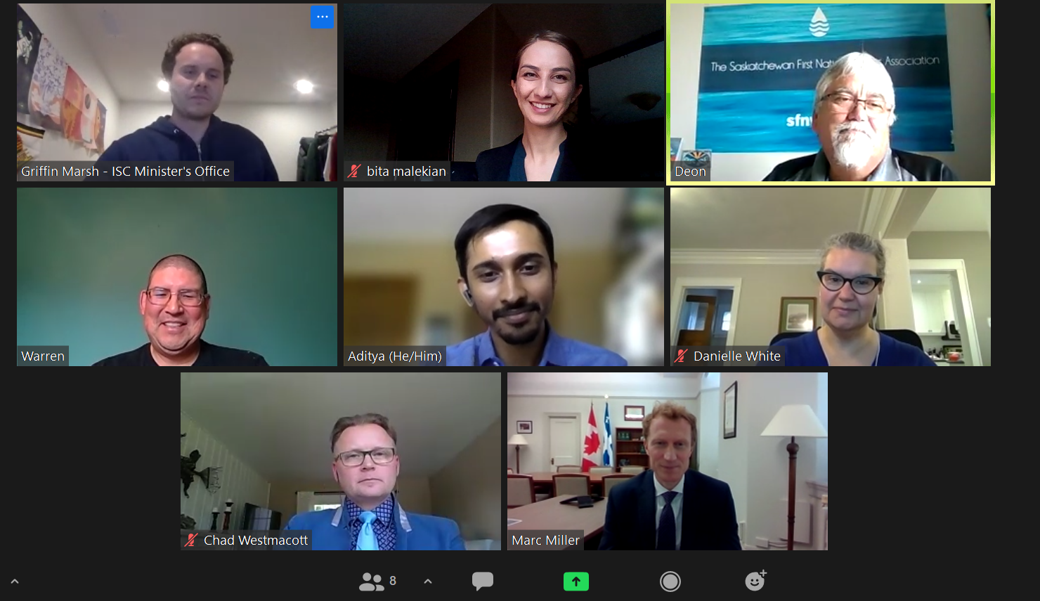Water Movement: Connecting Indigenous Water Operators in Their Fight for Safe Water
By Dawn McDevitt
Shina Novalinga describes Water Movement’s mission and vision, courtesy of the L’Oreal Paris Women of Worth Program. Screenshot from L’Oreal Paris Women of Worth Program.
Picture an adult who has grown up never knowing what it's like to safely drink water from the tap at home. Where would you guess they grew up? Canada? Seems at odds with having 20% of the world's fresh water.
In many Indigenous communities across Canada, water for drinking, washing, and bathing must be boiled for at least one minute to be safe. Some communities experience do-not-consume advisories, which means even boiled water is unsafe to drink. Fresh water issues affect First Nations, Inuit, and Métis communities.
The longest boil-water advisory in Canada began in 1995 and is still in place according to the Government of Canada. Many members of the Neskantaga First Nation, living about 450km north of Thunder Bay, Ontario, have never experienced life at home with potable tap water and have had to evacuate twice over the water crisis.
On First Nations reserves, chiefs, and councils are accountable to members for services, including water and wastewater systems, but the Indian Act limits their power to govern. The federal government still has jurisdiction over many aspects of life on reserves, and First Nations communities are prevented from managing their own water because of colonial-era laws.
In 2016 Prime Minister Justin Trudeau promised to end long-term water advisories on First Nations reserves by March 2021. But by the fall of 2020, the government acknowledged that it wouldn’t meet its deadline and additional funding was needed. As of June 2021, there were 51 long-term drinking water advisories impacting 32 Indigenous communities. An additional 31 short-term advisories were in effect as of July 2021.
Bita Malekian, a member of Calgary’s professional chapter of Engineers Without Borders, was inspired to get involved after hearing from Indigenous water facility operators about the challenges they face. “We spent the last three years listening to, learning from, and connecting with those on the frontlines of Canada's water crisis, Indigenous water treatment operators.”
Much of what Malekian heard pointed to a lack of training and collaboration opportunities. She recognized that an online platform could support water operators by helping to address the scarcity of training resources and the need to easily connect with other operators to problem-solve.
Water Movement was created as an online space for Indigenous water treatment operators to connect with each other, share lessons learned, and access learning resources. Malekian highlights the leadership and collaboration that forged and continues to shape Water Movement: “First and foremost, we are guided by an all Indigenous board of directors who help us along the mission and vision...and we are continuously adapting to the needs of the operators.”
Launched in January 2021, Water Movement has over 2,100 active users engaging on the platform through collaborative channels. Ask the Community serves as a forum for troubleshooting equipment issues. Lessons Learned encourages operators to share expertise, updates about new innovations, as well as tips and tricks. And the very popular Spotlight, is a space for recognizing exemplary operators.
Water Movement became a bridge for the individual expertise of water operators in different communities to form a body of knowledge and influence. “Notable operators like Warren Brown (Lytton First Nation) and Deon Hassler (Carry the Kettle Nakoda Nation) raised issues that were previously thought to be community-specific,” says Malekian. It became clear through posts and conversations on the platform that those issues are common to many Indigenous communities.
Taking stock of shared concerns and trends, Water Movement saw an opportunity to channel individual voices into a broader campaign, to convey the following calls to action to policymakers.
1. Develop a detailed allocation of the $1.5B investment (federal funding starting in the 2020–21 fiscal year to continue the work of ending long-term drinking water advisories on First Nations reserves.) Establish a clear and transparent oversight of the O&M (operations and maintenance) budget.
2. Help community leadership determine competitive Operator wages.
3. Recognize March 21st as National Indigenous Water Treatment Operator Day.
4. Support non-profit organizations like Water Movement working directly with operators to create valuable resources.
Getting an audience with leaders at the highest level of the Canadian government wasn’t easy. Members of the public voiced support and attention from celebrities like Academy Award winner Dame Helen Mirren, and Inuk throat singer Shina Novalinga, who both added to the momentum. The chorus of voices asked the Minister of Indigenous Services Canada (ISC), Marc Miller, to meet with operators from Water Movement and address their calls to action.
In May 2021, the water operators got the chance to speak directly with Minister Miller and presented their calls to action. “I think water should be the right of all our people, regardless of how many people are living on a certain reserve,” says Warren Brown, manager of Lytton First Nation Operations & Maintenance Department. "Ensuring the health and safety of a community's water supply is a role I take very seriously,” adds Deon Hassler, a Circuit Rider Trainer [qualified expert who trains water operators in First Nations communities] for File Hills Qu’Appelle Tribal Council from the Carry the Kettle Nakoda Nation. Malekian said the conversation opened the door to additional direct communication with the Minister’s team. “The Minister agreed to listen to, and work closer with, those on the frontlines of Canada’s water crisis. Additional meetings to understand Water Movement and how the government can support the initiative followed.”
Water Movement meeting virtually with Indigenous Services Canada (ISC). From left to right: Griffin Marsh, Acting Director of Policy, ISC; Bita Malekian, Water Movement Ambassador; Deon Hassler, Indigenous Expert Operator, Carry the Kettle Nakoda Nation, and Water Movement Director; Warren Brown, O&M Manager, Lytton First Nation, and Water Movement Director; Aditya Chaudhuri, Water Movement Ambassador; Danielle White, Assistant Deputy Minister, Regional Operations, ISC; Chad Westmacott, Director General Community Infrastructure, ISC; Marc Miller, Minister of Indigenous Services. Image courtesy of Water Movement.
As Water Movement evolves, it keeps user needs at the forefront. Next up is a mobile app. Water operators want to be able to access the platform via smartphone or tablet, and need access offline in remote locations. Development of the app is taking place in partnership with a team from the University of Calgary’s Schulich School of Engineering including professors and software experts Dr. Mohammad Moshirpur and Dr. Hamid Zaripour.
Water Movement is also expanding learning resources on the platform’s Video Learning Library. Twelve more expert operators will contribute to 100 new videos slated for launch by January 2022.
A documentary film is in the works, to boost awareness of Canada’s water crisis, highlight the important work that everyday people are doing, and show that each of us has a part to play in tackling it. The documentary is being filmed by volunteer videographer Matt Miller. It features current water leaders Warren Brown, Dr. Madjid Mohseni, Candace Cook, Dr. Michael Hart, and Disa Crowchief.
Water Movement Team interviews Dr. Michael Hart, Vice-Provost (Indigenous Engagement) from the University of Calgary, as part of an upcoming documentary project Water Movement is working on to advocate for better water access to Indigenous communities. Image courtesy of Water Movement.
Water Movement’s team participated in the 2021 “World’s Challenge Challenge” global finals, winning 3rd place among innovators from universities around the world. Malekian was also recognized with a 2021 sustainability award from the University of Calgary and a 2021 Women of Worth award from L’Oreal Paris.
“Water Movement is made possible through the joint efforts of volunteer Indigenous water treatment operators, videographers, editors, website developers, app developers, engineers, and students,” Malekian explains. “The tireless work of everyone involved has led to every success the organization has achieved...and this is only the beginning.”
Stay tuned with Water Movement to learn more and find out how to get involved:
Website: www.watermovementyyc.com/
Facebook: www.facebook.com/watermovementyyc/
LinkedIn: linkedin.com/company/watermovementyyc
Instagram: @watermovementyyc
Twitter: @Movement_Water
Tik Tok: @watermovementyyc



